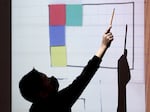
A student counts blocks as he solves a math problem in Eric Marsh’s third-grade class at Prescott Elementary in Portland, Feb. 8, 2022. Educators at the East Portland school are working to get students engaged and create a school community — two pieces of education that have been impacted by the long duration of the pandemic.
Kristyna Wentz-Graff / OPB
On a recent Tuesday, students in Eric Marsh’s third-grade class at Prescott Elementary were working together towards a single goal: getting a piece of candy.
But first, they have to find the area of the three-by-five rectangle on the wall. The class works together to find the answer, step by step, as Marsh and the students joke around with each other.
“This is new, we’re all learning it, does everybody learn stuff at the same time and in the same way?” he asked the class.
“No!” the students respond.
Marsh tried to call on students who didn’t have their hands raised.
“It can be embarrassing to put your voice out there,” Marsh said.
Students cheer each other on to get the right answer.
“Come on! For the sake of Starbursts!” One student yells out, as the student next to them laughs.
After a few tries and a few mistakes, the class figures it out.
“You guys are so amazing, so amazing,” Marsh tells the students as he passes out a Starburst candy to each of them.

Teacher Eric Marsh works with his third-grade students, (left to right) Sam, Steven, and Sadie. “The thing I hope most for the kids this year is that the harm of the pandemic … and the trauma of the pandemic is lessened to some degree by our joy at being together in class,” Marsh said.
Kristyna Wentz-Graff / OPB
As schools try to teach students what they need to know this year, teachers and other school staff are working to get students engaged and back in the rhythm of school again even as the world around them has changed.
“The thing I hope most for the kids this year is that the harm of the pandemic… and the trauma of the pandemic is lessened to some degree by our joy at being together in class,” Marsh said.
On the same day in another Prescott classroom, fourth- and fifth-grade teacher Jasmine Lowe oversees her students as math class wraps up. In the last few minutes of class, Lowe allows students to play learning games on their computer. Others are watching intently as two classmates play chess on a big mat spread out on a table.
This year, she wants her students to learn empathy and social skills they may have missed the last two years, in addition to academics.
“I hope that they learn and grow academically in their reading, in their math, in their writing, whatever. I just want to see growth,” Lowe says with a small laugh.
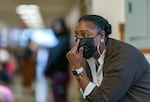
Prescott Principal Nichole Watson reminds a student to pull their mask up as she greets students in line for lunch.
Kristyna Wentz-Graff / OPB
Later in the day, Prescott principal Nichole Watson greets students as they head to lunch. A school staff member stands next to a student holding a sign with lunch options. As students wait in line to head to the lunchroom, a few dance around or pull their masks up over their noses after a reminder. Watson greets a new student and asks his new classmates to welcome him.
“Will you show Kevin the ropes?” Watson asks a student, as a teacher directs them to show their “new friend” the way to lunch.
Watson wants her students to see school as a place of belonging despite the barriers both inside the school and outside of it.
“I want for the six hours that our babies are here for us to do the heavy lifting,” Watson said. “But I also want them to know, ‘as I walk into this building, I’m responsible for what I bring in it, I’m responsible for the energy, and though sometimes I don’t always come as my best self, I want them to know this space has room and capacity for them’.”
In the classroom, a focus on individualized instruction, making mistakes, and building community
Eric Marsh takes time in his third-grade classroom to focus on mistakes, using himself as an example. He’s been learning how to ride a unicycle, sharing videos of his attempts with his students.
Then he connects it to a math concept, or what his students are attempting to learn.
“Oh, you don’t know how to multiply? Well I don’t know how to ride a unicycle, and I sure fall a lot, and you make a lot of mistakes, and that’s how we have to learn,” Marsh said. “We can’t learn without making a bunch of mistakes.”
He also wants students to feel comfortable and supported making mistakes in front of their classmates, creating a community feel in the classroom.
“The sense of kids as a community, and the sense of us as a group together, is more important than any one kid learning their multiplication tables… I feel like that has more lasting impact,” Marsh said.
And while that’s an easier task in-person than online, it’s hard to do in-person, as well, with the pandemic still standing in the way of students showing up. Marsh says he hasn’t had a full classroom since October.
“It’s overwhelming for me, and so kids sort of come and go, and they drop in when they can, and that feels different,” Marsh said.
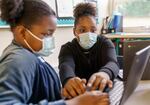
Pay’Chence, 10, left, and Amariana, 10, work together on math games in Jasmine Lowe’s combined fourth- and fifth-grade class. Lowe has been breaking kids into small work groups so she can observe their skills and help bring them back up to grade level.
Kristyna Wentz-Graff / OPB
In Jasmine Lowe’s fourth- and fifth-grade classroom, she can break students into small groups and observe how students are doing. During distance learning, she couldn’t always see whether students were completing the assignment or understanding.
“When we do these smaller groups I can really help with more individualized instruction and meeting them where they’re at, but helping them get back up to the grade level,” Lowe said.
Lowe has also picked up on a few things since the beginning of the year. She noticed that giving students choices in what to do in the classroom — whether through different “stations” set up in the classroom or letting them choose whether to work on a computer or with paper and pencil — has built motivation and accountability.
“I’ve noticed that giving them choice and the ability to pick through their stations has really helped with their engagement, and them participating,” Lowe said. “At the beginning of the year, we really struggled with being able to focus.”
Among students in Marsh and Lowe’s classes, reviews of in-person learning were positive.
One third-grader said internet issues made online learning difficult.
“I hate the glitches,” the third-grader said. “The computer is sometimes bad at loading… better to see people in person even though they’re wearing masks.”
“It’s fun, especially the fact that we can all eat candy and get parties and stuff,” said another student, excited about all the rewards that come with learning new things in school.
The classmate sitting at the table next to her said being in person is good, but they also missed being able to lay down and watch TV.
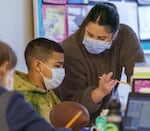
Reyes, 11, left, works with teacher Jasmine Lowe in class.
Kristyna Wentz-Graff / OPB
In Lowe’s class, fifth-grader Alex stands next to best friend, fourth-grader Nelly.
They both talk about the rush to find masks to wear every morning before school. But the two students are happy to be back in school and with each other.
“It’s much more fun to interact with people, and partner up with them, like my friends,” Alex said.
Dealing with the stress of return-to-school: student behavior and staff burnout
Between covering for absent colleagues, dealing with student attendance issues and continuing to enforce health and safety rules brought on by the pandemic, teachers and school staff continue to feel overburdened this school year. Watson is in just her second year as a principal. She was a teacher before the pandemic.
“They are exhausted, and they don’t make enough,” Watson said of her staff. “That coupled on top of whatever they bring into this space, whatever trauma they have endured through a global pandemic… they don’t just get to leave that at the door… they bring that with them, and our children bring it,” Watson said. “So it’s figuring out how do I support teachers so that they can support our babies.”
Watson has been doing “teacher swaps” all year, covering a class or two for teachers who are out. But at one point in January, the teacher absences got to be too much.
Teachers’ kids were out sick with COVID-19, or their kids’ schools were closing due to absences, or teachers had to quarantine or isolate. Watson tried to make up the staffing gaps with roving substitute teachers, and incentives for teachers to help, but it wasn’t enough.
So Prescott announced a one-day school closure. Then the whole Parkrose School District announced closures due to staffing issues. That lasted two weeks.
Watson said the distance learning time provided a “reset,” a chance to get folks out of quarantines and back feeling healthy and ready to teach.
School has been back in person since late January.
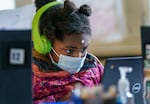
Jae’Lyia, 9, concentrates as she works on a math game in class.
Kristyna Wentz-Graff / OPB
“We’ve been smooth sailing so far,” Watson said.
Like other school leaders, Watson has also seen more behavior issues from students this school year. Student behavior isn’t a new problem, but in the pandemic, she said more students have the combined stresses of the trauma they experienced out of school while relearning how to be in a school environment.
“The behavior hasn’t increased, it’s the number of students impacted by this global thing that we all experienced,” Watson said.
She said it was a challenge at the beginning of the year, and it’s something staff are still working through. Halfway through the school year, Watson says staff continues to have conversations about discipline and how to best serve students while continuing to operate the school.
Watson has been using what she calls a “restorative discipline” approach, which includes engagement circles, sometimes between students and teachers.
“This building has to have capacity for conflict, but it also equally has to have capacity for repair,” Watson said.
She said she’s seeing adults think through discipline differently, and students using their voice to lead conversations and discussions about conflicts. It changes the way kids and adults interact.
“That is more relational than it is transactional,” Watson said, “and I need that in this time, for us to be really centered around that relational piece and how we restore one another.”
The way forward: creative solutions, need for resources
There have also been other changes at Prescott that have come out of the pandemic. Facing large class sizes in the early elementary grades and with those students needing more support, Watson created blended classrooms of first- and second-graders. That class size fix also allowed Watson to pair up veteran and new teachers for collaboration and mentorships in those classrooms.
And with a student population more familiar with technology than ever, connections to tech are present throughout the school from an early age. In a kindergarten classroom, students have QR codes that connect them to an online learning platform.
But this school year has also provided example after example of what schools — and students — still need.
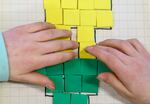
A student works a math problem in Eric Marsh’s third-grade class.
Kristyna Wentz-Graff / OPB
When school moved online, Marsh noted that not all of his students had access to technology to log on to class, leaving a heavier impact on students experiencing poverty, English language learners, or students of color.
“It felt like pre-existing inequalities were highlighted in that moment,” Marsh said.
Lowe said it’s been a hard year. Students are coming to school with trauma, and have more emotional needs. Her class spent time earlier this year focused on giving back to their community.
But Lowe says that in spite of the stress students are under, and the additional time spent building community, they’re making academic gains. She noted the results of a recent assessment which showed every student showing some growth.
“I was like, ‘oh, yes, goodness!’,” Lowe said. “It was a huge weight off my shoulders.”
But the year isn’t over, and she said students need more support — not just academically, but emotionally.
“We need more funding, we need more social workers, counselors, and psychologists,” Lowe said. “We need better support.”